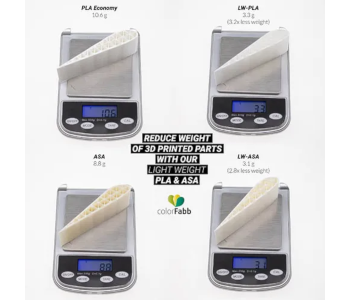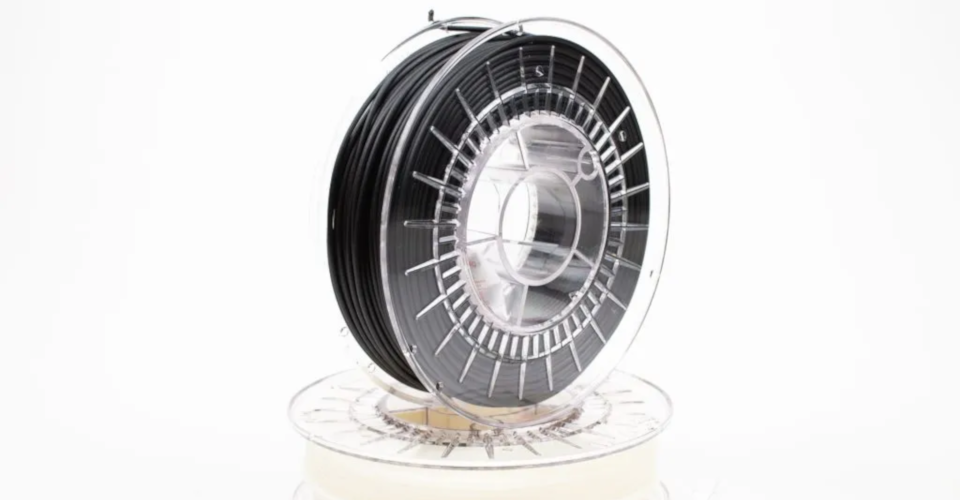What is Lightweight 3D Printing Filament?
Even today, one of the biggest advantages of owning an FDM 3D printer is the sheer range of 3D printing filaments available. Aside from the usual filament materials like PLA and ABS, there are also the composite filaments that simulate wood, metal, or ceramics.
There are also “enhanced” versions of standard filaments, such as high-temperature PLA or low-warping ABS. In this article, we are shining the spotlight on an example of an enhanced filament – the lightweight PLA from ColorFabb. What makes lightweight PLA special and how does it work?
What is the LW-PLA filament?

Simply put, the LW-PLA filament is a lightweight version of standard PLA. This may make lots of people wonder – what’s the point? After all, 3D printed objects are already naturally porous and lightweight.
This may be surprising for some, but PLA has one of the highest density values among all materials used in filament-based 3D printing. With a base value of 1.24 g/cm3, PLA is denser than ABS (1.04 g/cm3), TPU (1.21 g/cm3), and PC (1.19 g/cm3). The density of a filament material plays a huge role in determining how much an object of a set volume weighs.
LW-PLA can be tremendously useful for applications that require very-low-density parts. We can imagine using this filament to 3D print the hull or wing of a fixed-wing drone. Parts usually made using Styrofoam, such as costumes and props used in cosplay, can also be customized a lot more easily with 3D printing.
The use of foaming technology (which we shall discuss later on) also makes it possible to print a large-volume model using a surprisingly small amount of material, reducing both material consumption and printing time. According to colorFabb, users can decrease the filament flow by about 65% when printing with LW-PLA. At very high temperatures, LW-PLA even makes it possible to print layer heights that are larger than the size of the opening of the nozzle.
How does the foaming method work?
To achieve the unique lightweight characteristic, the LW-PLA filament uses active foaming technology. By combining PLA with a blowing agent, the filament produces gases when heated to 230 °C. These gases create pockets in the polymer, expanding its volume by almost three times and creating an internal cellular structure.
This description may conjure images of a suspiciously weak porous structure, similar to what you would get with a PLA filament that has moisture. The difference of LW-PLA is that it creates microscopic bubbles in a spatially consistent manner.
What this means is that the porous structure is barely visible to the naked eye. It even creates a visually appealing rough matte surface on the finished 3D printed part.
Another interesting behavior of the LW-PLA filament is that it expands more with increasing temperatures. Based on trials, the effective temperature range of LW-PLA is between 200 to 280 °C. However, printing speed and nozzle size also play a role in determining how much the material expands upon heating.
The effect on mechanical properties
It would be intuitive to assume that material with increased porosity would also have reduced mechanical strength. The LW-PLA filament gives us the perfect material to test this hypothesis. The results of a trial print test are summarized in the table below:
| Printing temperature | Density fraction | Tensile strength | Hook test | Stiffness test |
|---|---|---|---|---|
| 205 °C | Un-foamed | 49 MPa | 59 kg | 3200 MPa |
| 225 °C | 67% | 24 MPa | 30 kg | 1600 MPa |
| 250 °C | 44% | 12 MPa | 17 kg | 900 MPa |
The results show that the intuitive assumption is correct – parts printed at lower densities are weaker based on just about every metric. What is interesting to note is how strength parameters do not correspond proportionately to the reduction in density.
For instance, reducing the density to 67% results in a reduction in tensile strength to less than half of the un-foamed sample. Dropping the density further to 44% results in a tensile strength that is only about a quarter of the original material. This trend can be observed in all the other strength tests done in the trial.
This emphasizes how significant the tradeoff is between strength and density. If you’re planning to use the LW-PLA filament to produce lightweight materials, then this drop in mechanical properties is something you will need to plan for.
Tips for printing with LW-PLA
LW-PLA behaves unlike any other 3D printing filament, making it very difficult to anticipate how it will react to changing 3D printer settings. With this uncertainty in mind, these are some tips on using LW-PLA coming straight from ColorFabb:
Fine-tune extrusion settings
An unusual behavior of LW-PLA is that you seemingly end up with more material when you increase the printing temperature. This is due to the increasing foaming reaction. This means that you will need to reduce the extrusion speed with increasing temperatures if you want to avoid over-extrusion.
The expansion of LW-PLA approaches its peak at around 240 °C. This means that extrusion correction will be heaviest within the range of 210 to 240 °C. For instance, you can expect to reduce the printing speed by about half when going up from 220 C to 230 °C. If you see the filament bubbling up as it exits the nozzle, that is a clear sign that you need to reduce the printing speed.
Don’t print too slow
For most 3D printing professionals, printing slow is often the safer option. That is not the case when printing with LW-PLA. Take note that the filament starts to expand the moment that it is exposed to the heating element If you don’t get it out of the nozzle in time, it can expand inside the extruder and cause a clog.
ColorFabb recommends a minimum print speed of 30 mm/s for LW-PLA. If you plan to print at temperatures close to 260 °C, then you can adjust that speed up to 50 mm/s.
Anticipate stringing
The expansion of gases in the filament creates a lot of pressure for the material to flow through the nozzle. While this is beneficial for speeding up the print, it can also cause a lot of stringing while the nozzle travels. You can reduce this with some retraction but that is no guarantee that stringing will no longer occur.
Instead of wasting your time and effort to completely eliminate stringing, your energy is better spent removing the strings after. The great thing about this material is that its artifacts are very easy to remove. Just take a piece of sandpaper and sand off all the imperfections in your final print.
Vary temperature by layer
The behavior of LW-PLA filament with changing temperatures opens a lot of opportunities for creative avenues. If you want your parts to be lightweight but not flimsy, how about printing the outer walls at lower temperatures and the infill at higher temperatures? This will create a structure that is strong on the outside and very light inside.
If you have a dual-extruder 3D printer, you can even combine standard PLA with LW-PLA. This should create a part with even stronger features while maintaining a lightweight structure.
Final thoughts
The LW-PLA filaments is certainly one of the more interesting novelty filaments launched in the past couple of years. Through the innovative use of foaming technology, ColorFabb was able to produce the most lightweight filament yet.
LW-PLA behaves drastically different from conventional 3D printing filaments. For those who are printing with it for the first time, there will certainly be a learning curve to overcome. Tweaking the printing speed with changing temperatures is particularly important.
Right now, applications of LW-PLA have been limited mostly to RC planes. The advantage of LW-PLA in this field is obvious and makes the perfect proof of concept for a lightweight filament.
However, we would also like to see 3D printed props for movies or cosplay. Props in this industry have mostly been hand-made, after all. With 3D printing and lightweight filament, the process of making props can be faster and have better repeatability.


